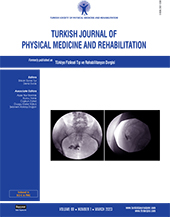Ultrasound evaluation of surgically repaired hand tendons during rehabilitation and its relation to clinical and functional assessment
Patients and methods: In the prospective observational study, 40 patients (29 males, 11 females; mean age: 27.4±10.7 years; range, 15 to 55 years) who presented with postoperative hand tendon repair between January 2019 and March 2020 were randomized into two groups: Group 1 included 15 subjects with 16 repaired flexor tendons, whereas Group 2 consisted of 25 subjects with repaired extensor tendons. Afterward, the assessment was performed at the four, eight, and 12 weeks of rehabilitation utilizing the total active motion of injured fingers, Visual Analog Scale (VAS), grip strength, ultrasound, and hand assessment tool (HAT).
Results: The study`s findings revealed a substantial improvement in pain based on the evaluation of grip strength, total active motion, VAS, and the affected hand`s HAT score in both groups (p<0.001). In both groups, ultrasonographic evaluation of healing tendons revealed considerable enhancement in margination, defect size, thickness, echogenicity, and vascularity. A positive correlation was detected between VAS and healing tendon margination as well as the HAT score and handgrip margination in Group 1.
Conclusion: High-frequency ultrasound is an easily accessible modality in the follow-up and evaluation of tendon healing after surgical repair and during a rehabilitation program.
Keywords : Hand assessment tool, musculoskeletal ultrasound, rehabilitation of repaired hand tendons

















